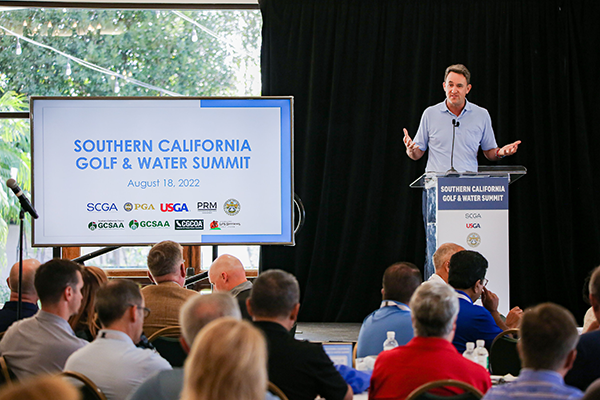Perhaps you haven’t already heard, but California is in a drought. Again. Or more accurately, still. Your latest reminder likely came in the form of the Metropolitan Water District’s (the region’s largest water supplier) mandate for residents to cut back water usage by 15%. While this may spell trouble for your lawn, it’s worth considering other green spaces that could be hurting from lack of water (i.e. your local golf course). Any time the issue of dwindling water resources comes up, golf courses are often among the first users to be offered for the chopping block. Let’s explore how major water restrictions could affect your course and what can be done:
How water restrictions can affect courses
Grass starts changing color

GOLFTV: PGA West
Let’s start with the obvious one: grass needs water to stay green. Anyone who’s ever had a lawn can tell you what happens when you forget to water it. That said, while even the most picturesque of California courses may not stay in pristine condition year round, you can still play golf with brown grass. Also, courses have developed methods of making sure that in times of water shortages, the most important areas (i.e. tees and greens) remain healthy.
Increased rates
Nobody likes to hear it, but the truth is the cost of keeping courses alive during a drought can incur significant costs. Whether it’s rising rates for water usage, increased maintenance to keep grass alive, or implementing methods to reduce water demand, it’s going to affect the bottom line. Ultimately, that could mean that your Saturday morning round just got a little pricier.
Reducing size
Here’s where things have the potential to get ugly. Given the difficulties of maintaining such large areas of land, some courses could decide that they need to make major changes to the layout to reduce their turf footprint. This could simply mean shortening or altering some holes, or it could mean getting rid of holes entirely.
Courses close

Photo: Golfweek
Worst case scenario. I’m not here to tell you that golf is going to cease to exist in Southern California any time in the near future. However, the reality is that there may be courses here and there that are simply unable to survive given the state’s current resources. Even if it’s not your home course or in your immediate area, losing a golf facility will result in increased play in a region where courses are already struggling to match the demand for golf.
How courses are combatting water shortages
Had enough doom and gloom? Me too. All of the things I just listed are a doomsday scenario for the unprepared. Fortunately, the drought is not news to course operators in California and they’ve spent years preparing for this exact moment.
Implementing high-tech irrigation systems
Golf courses have the highly sophisticated irrigation equipment and weather stations that determine exactly how much water the grass and soil needs at any given moment and the optimal time of day to activate the sprinklers. These systems also allow the grounds crew to target the areas of the course most in need of water and concentrate on keeping those areas hydrated. The target of these systems is to cut back water usage by 35%, which also may allow courses in certain areas to be exempt from further restrictions during periods of drought.
Removing unnecessary turf

Photo: OC Register
Many courses, especially those with large areas that are not typically in play for golfers, have opted to replace the turf in these areas with more drought-resistant plants or other materials that don’t require water. For example, in 2016 Los Robles Greens removed over 30 acres of turf from the facility and in doing so, dropped their water usage by over 20%.
Innovating new methods of conservation

The practices listed above are leading the charge to save water, but they’re also just part of the solution. Research groups are cultivating grass that’s ideal for courses in regions that stay warm year-round. Groundskeepers have eliminated overseeding. Courses have implemented means of recycling water or using non-potable water in their irrigation systems. The result? Less than 1% of the state’s potable water supply is being used by golf courses.
Relying on the SCGA for support
While the primary goal of all of this is to save water, it’s critical that these points are communicated whenever decisions on cutbacks are being made. It takes a unifying body to organize otherwise isolated golf courses into one voice capable of communicating these points to time-strapped water providers and policymakers. The SCGA has long filled that function in Southern California, and water providers and government agencies are accustomed to turning to SCGA to do just that in times of drought crisis.
How you can help
See, it’s not quite the end of the (golf) world. Before you go, though, I do want to reiterate the point that courses can’t survive without assistance from the greater golfing community. Here’s a few ways you can pitch in to keep the sport thriving:
Accept changes
Despite all the work being done that we just discussed, golf courses are still going to experience challenges due to environmental changes. What you can do is recognize that at times like these playing conditions may not be optimal, but because of the work put in throughout the region for more than a decade, they’re as good as Mother Nature and outside circumstances allow. Also understand that as important as they may think their recreational golf is, it is still a recreation; it’s not growing food, healing the sick, or servicing fundamental human needs. Keep things in perspective.
Support the SCGA

When (or perhaps if) you think of local golf associations like the SCGA, you probably associate us with things like getting a Handicap Index or running golf tournaments. What you may not realize is that when you join the SCGA, a portion of your membership dollars go directly to advocacy efforts with politicians and governmental bodies on behalf of golf. Whether it’s hosting summits for industry leaders or stopping municipal courses from shutting down, rest assured that the SCGA will rise to defend this game because our ultimate purpose is to make golf better for all SoCal golfers, not just our members.
Make your voice heard
All that said, no battle is won alone. Any time you find something that could threaten your golf courses, let your representatives know that you want to preserve golf for you and your community.
Golf is prepared for this moment. It’s been preparing for this moment and more such moments to come for a very long time. California is indeed the land of permanent drought, and golf has long been making plans to be part of it by continually investing in those technologies and practices capable of reducing the game’s water footprint over time. And the SCGA has been communicating that message to policymakers, media, and the non-golfing community that golf understands that continuing down this road at an accelerated clip is key to our survival in this land of permanent drought.



